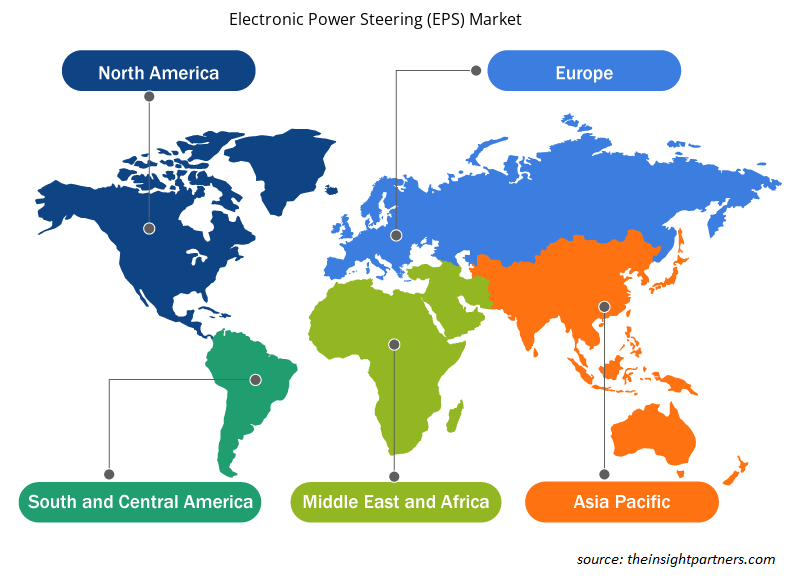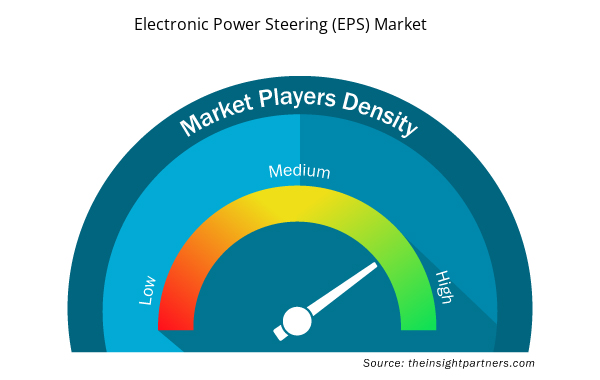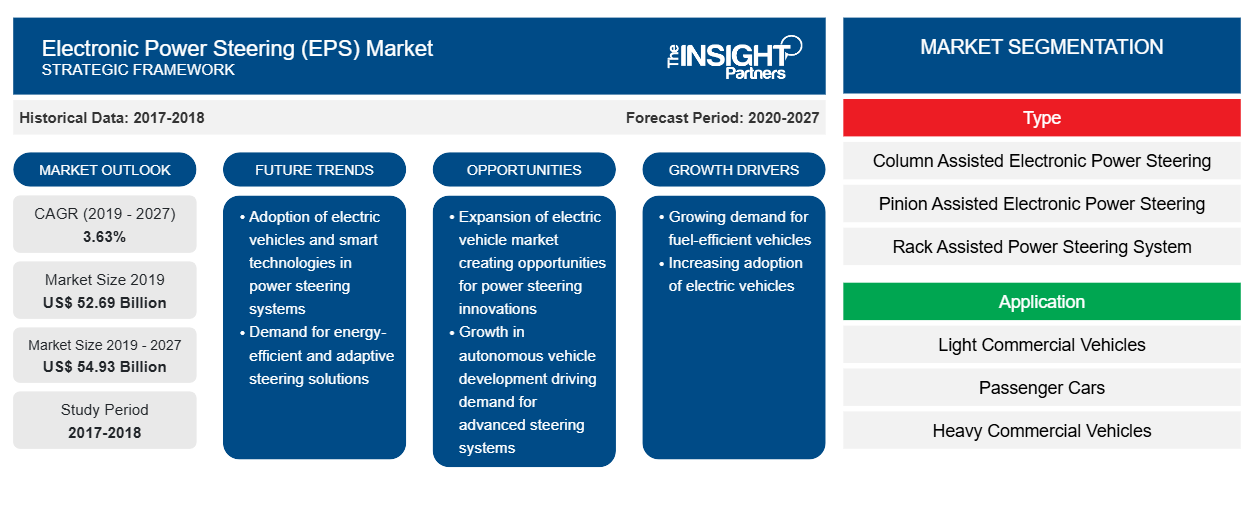Der weltweite Markt für elektronische Servolenkungen wurde im Jahr 2019 auf 52.692,31 Millionen US-Dollar geschätzt und dürfte im Prognosezeitraum von 2020 bis 2027 mit einer durchschnittlichen jährlichen Wachstumsrate von 3,63 % wachsen.
Der Markt für elektronische Servolenkungen ist grob in fünf große Regionen unterteilt: Nordamerika, Europa, APAC, MEA und SAM. Der Weltmarkt wurde 2019 von der Region APAC dominiert, die aufgrund der höheren Nachfrage nach elektronischen Servolenkungen fast die Hälfte des Gesamtmarktes ausmachte. Faktoren wie die stärkere Verbreitung von Premiumautos, Limousinen und SUVs unter der Bevölkerung der APAC-Region tragen erheblich zum größeren Marktanteil der Region bei. Darüber hinaus sind Ford Motor Company of Australia Limited, Toyota Motor Corporation Australia Limited, Mitsubishi Motors Australia Ltd. (MMAL), General Motors Holden, Isuzu Australia Limited, Volkswagen Group Australia Pty Ltd. und Hyundai Commercial Vehicles Australia einige der bekanntesten Nutzfahrzeughersteller des Landes. Alle diese Hersteller fordern die Integration von EPS in die Autos, um die steigende Nachfrage der Kunden zu decken. Darüber hinaus wird erwartet, dass die zunehmende Produktion im Automobilbereich, die steigende Nachfrage nach Elektrofahrzeugen und die zunehmende Konzentration der EPS-Hersteller auf das Angebot kostengünstiger und hocheffizienter Produkte das Wachstum des EPS-Marktes in den übrigen APAC-Ländern im Prognosezeitraum vorantreiben werden.
Markteinblicke – Markt für elektronische Servolenkungen
Steigende Verkäufe von Premiumautos in China
Passen Sie diesen Bericht Ihren Anforderungen an
Sie erhalten kostenlos individuelle Anpassungen an jedem Bericht, einschließlich Teilen dieses Berichts oder einer Analyse auf Länderebene, eines Excel-Datenpakets sowie tolle Angebote und Rabatte für Start-ups und Universitäten.
- Holen Sie sich die wichtigsten Markttrends aus diesem Bericht.Dieses KOSTENLOSE Beispiel umfasst eine Datenanalyse von Markttrends bis hin zu Schätzungen und Prognosen.
Im Jahr 2019 entfielen auf China fast 21,4 Millionen Fahrzeuge. Das Land ist der weltweit größte Produzent und Markt für Autoverkäufe. Dennoch sanken die gesamten Autoverkäufe im Jahr 2019 um ~1,9 %, aber die Nachfrage nach SUVs und Premium-Limousinen stieg im Vergleich zu 2018 um 3,5 % bzw. 18,8 %. Alle großen OEMs von Luxusfahrzeugen im Land, darunter BMW, Mercedes-Benz und Audi, meldeten im November 2019 positive Zahlen. Mit dem Anstieg der Verkäufe änderte sich auch das Marktszenario schnell. In der früheren Generation kauften die Verbraucher Premium-Fahrzeuge hauptsächlich, um ihren sozialen Status zu zeigen, aber die zunehmend anspruchsvollere neue Käufergeneration kauft Premium-Autos, um Luxus und clevere Technologien zu benötigen. Laut einer Studie der China Association of Automobile Manufacturers spielen Frauen auf dem chinesischen Premium-Automarkt eine bedeutende Rolle. Diese Umfrage ergab, dass Frauen bei der Wahl eines Fahrzeugmodells Sicherheitsmerkmale, Komfort und Außendesign höher bewerten als die von ihren Männern bevorzugten Eigenschaften wie Antriebstechnologie, gesellschaftlich anerkannte Premiummarken und größere Modelle. Die oben genannten Faktoren werden die Nachfrage nach der Integration von EPS in Limousinen und SUVs vorantreiben.
Auswirkungen von COVID-19
Die Halbleiter- und Automobilindustrie sind einige der Opfer von COVID-19, und seit Anfang 2020 verzeichnen diese Branchen einen rückläufigen Trend. Mit der Verhängung von Ausgangssperren in Ländern Nordamerikas, Europas und Asiens haben die Branchen erschütternde Erfahrungen gemacht. Die Automobilindustrie benötigt eine erhebliche Anzahl menschlicher Arbeitskräfte, und im Gegenteil, das COVID-19-Virus verbreitet sich durch menschliches Engagement, sodass der Sektor nicht richtig funktionieren kann. Der rückläufige Trend in der Automobil- und Halbleiterindustrie spiegelt einen negativen Einfluss auf den Markt für elektronische Servolenkungen wider.
Typsegment-Einblicke
Basierend auf dem Typ dominierte das Segment der elektronischen Servolenkung mit Lenksäulenunterstützung im Jahr 2019 den globalen Markt für elektronische Servolenkungen. Die elektronische Servolenkung ersetzt nach und nach das herkömmliche Lenksystem in modernen Fahrzeugen. Der Hauptvorteil der Verwendung einer elektronischen Servolenkung ist die Möglichkeit, den Energieverbrauch zu minimieren. Die elektronische Servolenkung mit Lenksäulenunterstützung (C-EPS) ist eine Art elektronischer Servolenkung.
Einblicke in das Fahrzeugtypsegment
Basierend auf dem Fahrzeugtyp hatte das Pkw-Segment 2019 den größten Anteil am globalen Markt für elektronische Servolenkungen. Pkw sind Transportfahrzeuge mit nicht mehr als acht Sitzen. Aufgrund der sich verschlechternden Wetter- und Luftqualität in Ländern wie Bangladesch, Pakistan, der Mongolei, Afghanistan und Indien nutzen die Menschen alternative Kraftstoffe und verwandte Technologien in ihren Pkws. Pkw können in Limousinen, Fließhecklimousinen und SUVs oder MUVs unterteilt werden. Die Nachfrage nach Pkws steigt mit steigendem Pro-Kopf-Einkommen und dem Bedürfnis nach Luxus.
Die Marktteilnehmer konzentrieren sich auf Produktinnovationen und -entwicklungen, indem sie fortschrittliche Technologien und Funktionen in ihre Produkte integrieren, um mit der Konkurrenz mithalten zu können.
- Im Jahr 2019 hatte Nexteer Automotive seinen Produktionsmeilenstein von 60 Millionen elektrischen Servolenkungen (EPS) weltweit bekannt gegeben. Diese könnten in Fahrzeugen von Kleinwagen bis hin zu großen Lastwagen zum Einsatz kommen. Die elektrischen Servolenkungen erhöhen die Kraftstoffeffizienz um 6 % und den CO2-Ausstoß um 8 Gramm pro Kilometer.
- Im Jahr 2018 hat die Robert Bosch GmbH Autobahnassistenzsysteme von Bosch für teilautomatisiertes Fahren in allen Fahrzeugen der Maserati-Modellreihe 2018 installiert. Darüber hinaus leistet die elektrische Servolenkung (EPS) von Bosch, eine weitere Innovation der Maserati-Modellreihe 2018, einen Beitrag zur Implementierung der Autobahnassistenztechnologie und anderer fortschrittlicher Fahrassistenzsysteme.
- Im Jahr 2018 hatte Hyundai Mobis ein elektrisches Servolenkungssystem entwickelt, das beim autonomen Fahren die Vorteile zweier elektronischer Schaltkreise nutzt, um unter allen Umständen die normale Lenkfähigkeit aufrechtzuerhalten.
Elektronische Servolenkung
Regionale Einblicke in den Markt für elektronische Servolenkungen (EPS)
Die regionalen Trends und Faktoren, die den Markt für elektronische Servolenkungen (EPS) während des gesamten Prognosezeitraums beeinflussen, wurden von den Analysten von Insight Partners ausführlich erläutert. In diesem Abschnitt werden auch die Marktsegmente und die Geografie für elektronische Servolenkungen (EPS) in Nordamerika, Europa, im asiatisch-pazifischen Raum, im Nahen Osten und Afrika sowie in Süd- und Mittelamerika erörtert.

- Erhalten Sie regionale Daten zum Markt für elektronische Servolenkungen (EPS)
Umfang des Marktberichts zur elektronischen Servolenkung (EPS)
| Berichtsattribut | Details |
|---|---|
| Marktgröße im Jahr 2019 | 52,69 Milliarden US-Dollar |
| Marktgröße bis 2027 | 54,93 Milliarden US-Dollar |
| Globale CAGR (2019 - 2027) | 3,63 % |
| Historische Daten | 2017-2018 |
| Prognosezeitraum | 2020–2027 |
| Abgedeckte Segmente | Nach Typ
|
| Abgedeckte Regionen und Länder | Nordamerika
|
| Marktführer und wichtige Unternehmensprofile |
|
Dichte der Marktteilnehmer für elektronische Servolenkungen (EPS): Auswirkungen auf die Geschäftsdynamik
Der Markt für elektronische Servolenkungen (EPS) wächst rasant, angetrieben von der steigenden Nachfrage der Endnutzer aufgrund von Faktoren wie sich entwickelnden Verbraucherpräferenzen, technologischen Fortschritten und einem größeren Bewusstsein für die Vorteile des Produkts. Mit steigender Nachfrage erweitern Unternehmen ihr Angebot, entwickeln Innovationen, um die Bedürfnisse der Verbraucher zu erfüllen, und nutzen neue Trends, was das Marktwachstum weiter ankurbelt.
Die Marktteilnehmerdichte bezieht sich auf die Verteilung der Firmen oder Unternehmen, die in einem bestimmten Markt oder einer bestimmten Branche tätig sind. Sie gibt an, wie viele Wettbewerber (Marktteilnehmer) in einem bestimmten Marktraum im Verhältnis zu seiner Größe oder seinem gesamten Marktwert präsent sind.
Die wichtigsten auf dem Markt für elektronische Servolenkungen (EPS) tätigen Unternehmen sind:
- Hyundai Mobis
- JTEKT Corporation
- Mitsubishi Electric Corporation
- Nexteer Automobile
- NSK GmbH.
Haftungsausschluss : Die oben aufgeführten Unternehmen sind nicht in einer bestimmten Reihenfolge aufgeführt.

- Überblick über die wichtigsten Akteure auf dem Markt für elektronische Servolenkungen (EPS)
Der globale Markt für elektronische Servolenkungen ist wie folgt segmentiert:
Markt für elektronische Servolenkungen – nach Typ
- Elektronische Servolenkung mit Lenkradunterstützung
- Pinion-unterstützte elektronische Servolenkung
- Zahnstangenunterstütztes Servolenkungssystem
- Elektronische hydraulische Servolenkung
Markt für elektronische Servolenkungen – nach Fahrzeugtyp
- Leichte Nutzfahrzeuge
- Pkw
- Schwere Nutzfahrzeuge
Markt für elektronische Servolenkungen – nach Regionen
Nordamerika
- UNS
- Kanada
- Mexiko
Europa
- Frankreich
- Deutschland
- Italien
- Vereinigtes Königreich
- Russland
- Restliches Europa
Asien-Pazifik (APAC)
- China
- Indien
- Südkorea
- Japan
- Australien
- Restlicher Asien-Pazifik-Raum
Naher Osten und Afrika (MEA)
- Südafrika
- Saudi-Arabien
- Vereinigte Arabische Emirate
- Rest von MEA
Südamerika (SAM)
- Brasilien
- Argentinien
- Rest von SAM
Markt für elektronische Servolenkungen – Unternehmensprofile
- Hyundai Mobis
- JTEKT Corporation
- Mitsubishi Electric Corporation
- Nexteer Automobile
- NSK GmbH.
- Robert Bosch GmbH
- Showa Corporation
- Die Mando Corporation
- ThyssenKrupp AG
- ZF Friedrichshafen AG
- Historische Analyse (2 Jahre), Basisjahr, Prognose (7 Jahre) mit CAGR
- PEST- und SWOT-Analyse
- Marktgröße Wert/Volumen – Global, Regional, Land
- Branche und Wettbewerbsumfeld
- Excel-Datensatz


- Long Read Sequencing Market
- Ceramic Injection Molding Market
- Animal Genetics Market
- Print Management Software Market
- Electronic Shelf Label Market
- Equipment Rental Software Market
- Railway Braking System Market
- Health Economics and Outcome Research (HEOR) Services Market
- Emergency Department Information System (EDIS) Market
- Data Center Cooling Market

Report Coverage
Revenue forecast, Company Analysis, Industry landscape, Growth factors, and Trends

Segment Covered
This text is related
to segments covered.

Regional Scope
North America, Europe, Asia Pacific, Middle East & Africa, South & Central America

Country Scope
This text is related
to country scope.
Häufig gestellte Fragen
The electronic power steering (EPS) market is led by passenger cars segment with highest share and is expected to dominate in the forecast period. Passenger cars are the transport vehicles with not more than eight seats. Due to the worsening weather and air quality in countries, such as Bangladesh, Pakistan, Mongolia, Afghanistan, India, people are adopting alternative fuel and related technologies in their passenger cars. Passenger cars can be divided into sedan, hatchback, and SUV or MUV. The demand for passenger vehicles is increasing with a rise in per capita income and need for luxury. The electronic power steering system is linked to the vehicle control unit.
There is an increase in adoption of buses and trucks, specifically for logistics and public transportation purposes, across the globe. In Asia, Oceania, and Europe, the public transportation is used more as compared to private transportation, whereas in North America, transportation is mainly through private vehicles. Growing population in urban areas is demanding the increasing public transportation with the improvement in existing transportation infrastructure is proving to be insufficient. The OEMs across the globe are now focusing on reducing the global carbon footprint, therefore, boosting the usage of electric vehicles is anticipated to offer ample growth opportunities for the global electronic power steering (EPS) market players.
Rising adoption of autonomous driving worldwide is one of the major factors boosting the adoption of steer-by-wire systems in the vehicles. SbW is enhancing the driving experience as well as safety. The SbW technology is currently experiencing a constant surge in development as well as demand. The higher levels of autonomous driving require uninterrupted communication, redundant power supply, and steering rack. Moreover, the SbW enhances the safety with the help of driver assistance systems. It also eliminates the intermediate steering shaft and thus, reduces the risk of injury to the driver from mechanical steering components by augmenting the passive safety in the vehicle.
Trends and growth analysis reports related to Automotive and Transportation : READ MORE..
The List of Companies - Electronic Power Steering Market
- Hyundai Mobis
- JTEKT Corporation
- Mitsubishi Electric Corporation
- Nexteer Automotive
- NSK Ltd.
- Robert Bosch GmbH
- Showa Corporation
- The Mando Corporation
- ThyssenKrupp AG
- ZF Friedrichshafen AG
The Insight Partners performs research in 4 major stages: Data Collection & Secondary Research, Primary Research, Data Analysis and Data Triangulation & Final Review.
- Data Collection and Secondary Research:
As a market research and consulting firm operating from a decade, we have published and advised several client across the globe. First step for any study will start with an assessment of currently available data and insights from existing reports. Further, historical and current market information is collected from Investor Presentations, Annual Reports, SEC Filings, etc., and other information related to company’s performance and market positioning are gathered from Paid Databases (Factiva, Hoovers, and Reuters) and various other publications available in public domain.
Several associations trade associates, technical forums, institutes, societies and organization are accessed to gain technical as well as market related insights through their publications such as research papers, blogs and press releases related to the studies are referred to get cues about the market. Further, white papers, journals, magazines, and other news articles published in last 3 years are scrutinized and analyzed to understand the current market trends.
- Primary Research:
The primarily interview analysis comprise of data obtained from industry participants interview and answers to survey questions gathered by in-house primary team.
For primary research, interviews are conducted with industry experts/CEOs/Marketing Managers/VPs/Subject Matter Experts from both demand and supply side to get a 360-degree view of the market. The primary team conducts several interviews based on the complexity of the markets to understand the various market trends and dynamics which makes research more credible and precise.
A typical research interview fulfils the following functions:
- Provides first-hand information on the market size, market trends, growth trends, competitive landscape, and outlook
- Validates and strengthens in-house secondary research findings
- Develops the analysis team’s expertise and market understanding
Primary research involves email interactions and telephone interviews for each market, category, segment, and sub-segment across geographies. The participants who typically take part in such a process include, but are not limited to:
- Industry participants: VPs, business development managers, market intelligence managers and national sales managers
- Outside experts: Valuation experts, research analysts and key opinion leaders specializing in the electronics and semiconductor industry.
Below is the breakup of our primary respondents by company, designation, and region:

Once we receive the confirmation from primary research sources or primary respondents, we finalize the base year market estimation and forecast the data as per the macroeconomic and microeconomic factors assessed during data collection.
- Data Analysis:
Once data is validated through both secondary as well as primary respondents, we finalize the market estimations by hypothesis formulation and factor analysis at regional and country level.
- Macro-Economic Factor Analysis:
We analyse macroeconomic indicators such the gross domestic product (GDP), increase in the demand for goods and services across industries, technological advancement, regional economic growth, governmental policies, the influence of COVID-19, PEST analysis, and other aspects. This analysis aids in setting benchmarks for various nations/regions and approximating market splits. Additionally, the general trend of the aforementioned components aid in determining the market's development possibilities.
- Country Level Data:
Various factors that are especially aligned to the country are taken into account to determine the market size for a certain area and country, including the presence of vendors, such as headquarters and offices, the country's GDP, demand patterns, and industry growth. To comprehend the market dynamics for the nation, a number of growth variables, inhibitors, application areas, and current market trends are researched. The aforementioned elements aid in determining the country's overall market's growth potential.
- Company Profile:
The “Table of Contents” is formulated by listing and analyzing more than 25 - 30 companies operating in the market ecosystem across geographies. However, we profile only 10 companies as a standard practice in our syndicate reports. These 10 companies comprise leading, emerging, and regional players. Nonetheless, our analysis is not restricted to the 10 listed companies, we also analyze other companies present in the market to develop a holistic view and understand the prevailing trends. The “Company Profiles” section in the report covers key facts, business description, products & services, financial information, SWOT analysis, and key developments. The financial information presented is extracted from the annual reports and official documents of the publicly listed companies. Upon collecting the information for the sections of respective companies, we verify them via various primary sources and then compile the data in respective company profiles. The company level information helps us in deriving the base number as well as in forecasting the market size.
- Developing Base Number:
Aggregation of sales statistics (2020-2022) and macro-economic factor, and other secondary and primary research insights are utilized to arrive at base number and related market shares for 2022. The data gaps are identified in this step and relevant market data is analyzed, collected from paid primary interviews or databases. On finalizing the base year market size, forecasts are developed on the basis of macro-economic, industry and market growth factors and company level analysis.
- Data Triangulation and Final Review:
The market findings and base year market size calculations are validated from supply as well as demand side. Demand side validations are based on macro-economic factor analysis and benchmarks for respective regions and countries. In case of supply side validations, revenues of major companies are estimated (in case not available) based on industry benchmark, approximate number of employees, product portfolio, and primary interviews revenues are gathered. Further revenue from target product/service segment is assessed to avoid overshooting of market statistics. In case of heavy deviations between supply and demand side values, all thes steps are repeated to achieve synchronization.
We follow an iterative model, wherein we share our research findings with Subject Matter Experts (SME’s) and Key Opinion Leaders (KOLs) until consensus view of the market is not formulated – this model negates any drastic deviation in the opinions of experts. Only validated and universally acceptable research findings are quoted in our reports.
We have important check points that we use to validate our research findings – which we call – data triangulation, where we validate the information, we generate from secondary sources with primary interviews and then we re-validate with our internal data bases and Subject matter experts. This comprehensive model enables us to deliver high quality, reliable data in shortest possible time.


 Holen Sie sich ein kostenloses Muster für diesen Bericht
Holen Sie sich ein kostenloses Muster für diesen Bericht